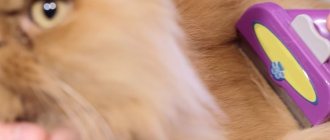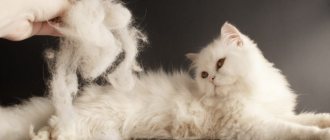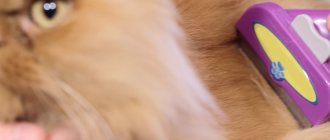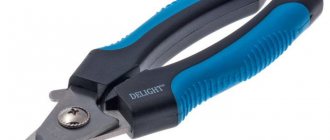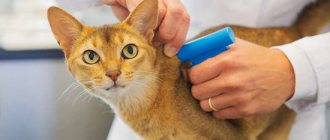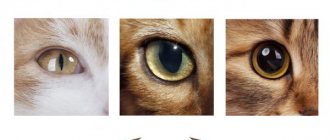A cat in the house is like a small child requiring attention and care. The owner of a furry friend has to regularly carry out procedures for caring for the animal's fur, cleaning the ears and trimming sharp claws. However, it is not necessary to cut them off, but if you exclude the need for such a procedure, property may be seriously damaged.
Cats have a well-developed natural instinct for sharpening their claws on different surfaces. If yard pets use tree bark for this purpose, then domestic cats will happily scratch their sharp claws on the upholstered furniture, carpet or wall with wallpaper.
To prevent damage to property in the house, you can purchase a special accessory for carefully cutting off cat claws - a nail clipper. In this article we will look at the types of nail clippers, how to use them and which one to choose for your pet.
Why does a cat need a manicure?
The cat's hard, sickle-shaped claws, which grow and renew throughout its life, are its formidable weapon, as well as a useful tool that allows it to storm trees and other heights.
In their natural environment, animals have many opportunities to wear down their claws, making them easier to renew. At home, cats have no choice but to be satisfied with a scratching post, wallpaper, door frames, curtains, carpets and, of course, upholstered furniture, which, in their opinion, is simply created for sharp claws to stick into. Tearing soft surfaces is, rather, a pleasant pastime for a cat. It does not provide either grinding of the claws or their shortening, and the animal has to experience discomfort, accidentally clinging with “scratches” to all suitable objects. Sometimes the kitty cannot even free its paw on its own, and then plaintively cries out for help.
It is dangerous to play with a pet armed with long, sharp, curved claws. The first to suffer from them are, of course, children. Don't think that the main threat comes from the cat's front paws. The claws on the hind, pushing, paws, although they grow more slowly, are stronger and tougher. It is with these “daggers” that a pet that has played out can accidentally inflict the most dangerous and deep wound.
In short, regular trimming of cat's claws eliminates or minimizes many problems. This procedure will require patience on the part of the owner, and also a lot of time, because you need to do more than just trim the curved tips of the claws. You will have to follow a certain technique, know at what angle to hold the tool, how to ensure the safety of the “operation”.
Alternative Methods
Modern developments involve the use of adhesive silicone caps. If the owner is afraid to trim his pet’s nails, and for some reason does not want to contact a professional groomer or veterinarian, he can use this method.
The idea is this: glue is applied to each claw, which comes with the attachments, and a cap is put on it. The claws remain intact, but at the same time, thanks to the soft material, the cat cannot scratch or damage the wallpaper and furniture. Over time, the glue wears off and the caps fall off. Many owners are also attracted by the fact that the nozzles are sold in different colors and it looks stylish.
However, there are some points that call into question the safety of this method. For example, due to a rather thick layer of the nozzle, the cat cannot retract its claws correctly. This sometimes affects the position of the limbs and gait. Another unpleasant sensation for a cat is the inability to scratch properly with such soft claws. Some pets tolerate this method of nail care well, while others get nervous, try to remove the caps, and may choke.
What toothpaste and brush are required for cats, their price and how often should you brush your teeth?
There are owners who decide to undergo the “soft paw” operation. At first glance, everything is fine - sharp claws are removed once and for all, which eliminates many problems. However, it is rare that a conscientious veterinarian will agree to do something like this without instructions. Onychectomy (as the operation is scientifically called) is a serious surgical intervention, as a result of which part of the distal phalanx of each finger is removed along with the claw, nerves, and blood vessels.
Inspecting the condition of the cat's claws
After this, the cat is unable to scratch - there is simply nothing with which to scratch. However, such a pet will never be able to become full-fledged.
Due to the amputation of a fragment of a finger, gait is often disturbed, the pet loses the ability to climb, sometimes balance decreases, the cat cannot play well, since there is nothing to catch toys with, and cannot itch.
Separately, it is worth considering the recovery period after surgery, when the cat experiences pain and discomfort.
Usually such an operation is indicated for pathological reasons - injuries, malignant neoplasms, etc., but there are owners who consciously take this step in order to make caring for their pet easier.
How to trim a dog's nails. Step-by-step instruction
Not every four-legged pet easily tolerates the process of trimming its nails. Most dogs experience discomfort and try in every possible way to avoid this procedure. But the owner must understand that if the dog does not spend most of his time outside, then claw trimming is indispensable.
Most owners prefer going to a specialized clinic. There is an opinion that it is impossible to perform the procedure on your own and you should trust only a veterinarian.
In fact, the situation is somewhat different. Any owner can easily trim his pet's nails himself. To do this, you just need to familiarize yourself with the theory, purchase the right tool and practice a little.
Types of nail clippers
The stores offer a wide selection of nail clippers: scissors, pruners and others. They all differ in shape and size.
- Claw cutter - guillotine. Made in the shape of a guillotine, which was used to carry out executions during the Inquisition. The principle of operation of the tool: insert the claw plate into the hole and, by pressing the handle, cut off part of the claw. It has a disadvantage: when the mechanism is pressed, the claw being trimmed is not visible. As a result, there is a risk of injury to the animal.
- Nail cutter - scissors. Has holes for fingers. They differ from ordinary scissors in the shape of the blade - they have a cutout into which the claw plate is inserted. It is safe due to the low level of injury risk.
- Nail clipper - secateurs. The shape resembles a pruning shear. The handles of the tool have a rubberized structure, which allows you to trim claws efficiently and painlessly. This tool has an advantage - it has a limiter that prevents damage to the claw plate.
- Electric nail clipper. It is a professional cat care tool. The device has a wheel on which the claw plate is ground. This type of nail clipper should only be used by experienced pet owners.
- Nail clipper with claw catcher. A type of nail clipper is a guillotine. It has a device that can fix the cut off part of the claw.
Before purchasing, you need to inspect the animal's paws. For kittens and miniature breeds, scissors are suitable, and for cats with thick nail plates, it is best to choose a guillotine.
The nail clipper should be comfortable to use. Before you make a purchase, you need to hold the nail clipper in your hand. If your hand is comfortable, then you can make a purchase.
The blades of the nail clipper must be sharp and made of durable steel. Handles must be made of durable plastic and have holes for fingers.
Can I cut my hair with scissors?
Some owners try to improvise and cut their cats' claws with regular nail scissors. But the shape and structure of a human nail is very different from a cat's claw. Such manipulations often lead to problems such as crooked edges that scratch just as much as untrimmed claws, separation of the stratum corneum and various injuries.
The shape and design of any scissors is not suitable for removing excess parts of the nail, but this tool is also important for caring for your pet’s paws. Scissors are very convenient for trimming the hair between the toes of fluffy cats; if necessary, they can also trim the thin layer of the claw that has peeled off. But no scissors are suitable specifically for trimming claws.
Features of use
Before the procedure, the owner must calm down, otherwise the pet will feel fear and behave nervously. If the animal is still afraid, then carry out the procedure several times as accurately as possible, however, do not cut the claws. Such preparation is necessary so that the dog understands the procedure and feels more confident. Over time, use the nail clipper on a pencil or other object to demonstrate a special sound to your pet. Trim 1 claw after 5-7 preparatory procedures.
Accompany the preparation process with rewards and treats. The goal is for the dog to understand the procedure and its safety in as much detail as possible.
Rules for using guillotine and pruning tools.
Sterilize nail clippers with alcohol or vodka. You also need to disinfect your hands or gloves. The dog's paws should also be washed and dried. If possible, you can trim the nails immediately after bathing. At this time they are as soft and pliable as possible. Take a close look at your pet's claws. If they are light, the pulp (tissue with blood vessels) will be easy to see
It is important not to touch it when circumcising. The cut should be located 1.5-2 mm from the edge of the pulp. If the dog has black claws, then you need to cut them 0.5 mm at a time.
The procedure should be completed as soon as a pink dot or a place that looks like a wet spot appears in the middle of the claw. Start cutting the claws off the front paws. The dog must stand on the floor or a special non-slip table. With your left hand, press the pad of your finger to extend the claw. With a quick movement, make a cut at a 45° angle towards the inside of the foot by 1 mm. Continue cutting 0.5mm increments until you are the desired distance from the pulp.
You cannot cut the claw straight to the pulp in one movement. The risk of injury is too great. If you touch living tissue, it will hurt the animal. If the dog twitches at this moment, then there is a risk of completely tearing out the claw.
The principle of using a trimmer is slightly different from cutting tools. There is no need to trim the claws, they are simply filed. Grinders have several attachments in a set, which are made from grinding stone.
First aid for injuries
Most dogs are very worried before trimming their nails , even if they have not experienced negative emotions about this before. One option is relaxation medications. As a rule, sedatives are produced from herbs and weaken nervous excitability, all this gives exactly the effect that is required for a cosmetic procedure. Then prepare special powder, powder or wipes with hemostatic properties. If you cut the claw too deeply, several dozen important vessels will be damaged. Quite often, injuries are accompanied by severe bleeding, and this initiates mutual panic for both dog and owner.
It is important to know that under no circumstances should you treat a damaged claw with the following drugs:
- iodine;
- fucorcin;
- hydrogen peroxide;
- dimexide;
- alcohol;
- brilliant green;
- vodka.
If you don’t have special powder or baby powder nearby, then ordinary food flour will do. All kinds of cauterizing and alcohol-containing solutions will only increase the pain!
Another rather difficult injury is claw tearing . Most often, this happens if you squeeze the nail clippers for a long time, and the dog suddenly jerks its paw. The secured claw remains in the clamp, and the soft tissue and skin are torn.
The first thing to remember is that this is very painful for the dog! Get ready for your tailed friend to whine loudly and try to run away. Operate quickly enough and without panicking:
- Constantly talk to the dog, console him, do everything in order to distract him from what is happening.
- Intercept the wounded paw with a piece of gauze in the area of the wrist (metatarsus).
- Tighten and secure the gauze thoroughly, while it is recommended to raise the limb as high as possible. Apply cold to the injured paw - ice, a piece of minced meat, frozen vegetables taken from the freezer. Wrap the compress in cotton cloth and cellophane in advance. Cold can help stop blood flow and moderate the pain to some extent.
- Carefully examine the wound, and if there are open tissue tears, fill them with novocaine or lidocaine.
The Pros and Cons of Trimming Domestic Cats' Nails
This procedure helps protect small children in the house from scratches, when an overly naughty pet can get carried away and accidentally harm the child. In addition, wallpaper, expensive furniture and other household items and clothing will not be damaged. If there are several cats in the house, this will also protect them from injuring each other during quarrels. The main argument animal advocates make against nail trimming is valid. This is the only vital “tool” of an animal, with the help of which it can climb up a tree trunk or building, defend itself from enemies, and get food for itself. Therefore, you should not trim the claws of cats that often walk outside; they are automatically at risk.
For young and active, exclusively domestic pets, this procedure is acceptable if performed correctly and with an excellent tool.
Nail trimming is a must:
- If you plan to take your pet to a breeding, exhibition or show. In a stressful environment, a cat may accidentally injure a partner or person.
- When the claw grows too quickly. This is typical of the Persians and Sphinxes. With a lack of vitamins D and B, the stratum corneum often peels off and breaks, and the animal may accidentally pull out a claw.
- When the pet is very old, when it is not able to grind its claws on its own. Trimming this often prevents the nail plate from growing into the paw pad.
Is a haircut often necessary?
You are unlikely to hear a clear and unambiguous answer on the frequency of trimming nails even from a veterinarian. The age of the animal, its lifestyle, the level of street activity and the surface on which the dog moves most of the time are taken into account.
The comfort of apartments with their laminate, linoleum or parquet means that the dog’s nails will have to be trimmed quite often.
With an active outdoor lifestyle, with walking on hard surfaces, the dog will not need frequent nail trimming. In this case, the natural grinding process will correct everything itself.
global $ads_google; //data-ad-slot=”2475549904″ $ads_google = empty($ads_google) ? false : true; ?> if ($ads_google == false) {?>
$ads_google = true; ?> } ?>
Veterinarians can answer in more detail: the blood vessels that are in the claw grow with it. The less often you cut, the easier it will be to damage the vessel. The dog will definitely not appreciate such “care” then.
Types of nail clippers
There are a large number of nail clippers for cats, but I would like to highlight four main types that can most often be found in pet stores:
- A claw cutter in the form of scissors looks like the usual small scissors with only one difference - on each blade of the tool there are special rounded cutouts into which the claw is inserted during the cutting process.
- Nail clippers look like pliers with thick rubberized handles. Nail clippers of this type are additionally equipped with a special blade locking mechanism, which makes their use and storage safe, for example, if there is a child in the house. The essence of this mechanism is as follows: at the base of the blades there is a special lever that makes it impossible to open the blades and use the nail clipper unless this lever is moved to the opposite position. Also, most models of pliers-type nail clippers have a special limiter that helps to cut only the required and safe length of the claw.
- A guillotine-shaped cat nail clipper got its name because of the operating principle of the cutting surface, exactly like the well-known fatal device in the Middle Ages. One of the significant disadvantages of this type of nail cutter is the inability to fully see how long the claw needs to be cut off. But even this fact does not prevent most cat owners from choosing this particular nail clipper, which makes it one of the most popular tools for claw care today.
- Electric nail grinders are most often used in professional grooming salons or by very experienced cat owners at home. The operating principle of such a nail cutter is to grind the claw down on a rapidly rotating wheel, which is coated with an abrasive coating. Typically, a set of such a nail clipper comes with various attachments, both with limiters for absolutely safe grinding of the claw, and without limiters.
Tools and their prices
In addition to maintaining the health of your four-legged friend, caring for your cat’s claws is also necessary to ensure that the cat does not damage furniture and other items in the house, as often happens. If a cat, living in a house or apartment, has access to the street, its claws should not be trimmed. Coming out of hiding unarmed is very dangerous. However, if the pet is a complete sofa dweller, the owner decides whether to shorten the claws or not. The main thing is to prevent excessive nail growth.
Necessary tools that the owner must have:
We trim the claws with special pliers
Hair clippers
You can also often hear the name “nippers”. This is a convenient and inexpensive tool, it comes in different sizes, but small ones are suitable for cats. It looks like a cross between small short scissors and curved wire cutters.
The working surface is semicircular and sharp, which allows you to grasp the claw, fix it and trim it. Prices vary - it all depends on the manufacturer, the materials from which the tool is made and the size of the nail clipper: from 50 to 550 rubles.
We use a nail cutter - a guillotine to trim claws
Nail clipper guillotine for trimming
It is also often used by professional groomers (people who tidy up the appearance of animals: bathe, cut, comb, treat eyes, ears, claws, etc.) and ordinary owners.
The design of a claw cutter - guillotine - is a solid ring where the tip of the claw is placed, and a small flat sharpened plate, which, in fact, chops off the excess. Operated by a spring handle. You can buy it at any pet store for about 100 – 600 rubles.
Specialized nail file
Files
Everyone knows the tools that people actively use. They have a rough flat surface made of metal, glass, plastic or cardboard, which removes and trims the excess edge of the claw. Well suited for combined work with nail clippers. You can buy it in pet stores, as well as in any stores that sell manicure products. It is better to choose fine or medium grain. Prices vary greatly: from approximately 40 to 350 rubles.
A special toy for grinding down cat claws
Scratching posts
In turn, they can be vertical (climbing posts, various designs, flat boards for mounting on the wall, wrapped in sisal or synthetic rope, or simply having a rough surface), horizontal (thick mats, wavy surfaces and similar devices) and in the form of small toys (balls, mice, rollers, also wrapped with a special rope or thread so that the surface is rough).
You definitely need to purchase at least one option for your pet, which will certainly please the cat and will be very beneficial for health. Toys are cheaper: from 25 rubles, rugs and small structures can be bought for about 170 - 900 rubles, large climbing areas with houses and transitions cost from 1,600 rubles to 45,000 rubles.
Toys, rugs, posts - scratching posts wear out over time, so it is important to monitor the condition of the item and periodically replace either the coating or the entire structure.
The best mechanical nail clippers
Hello Pet 20112L
Rating: 4.9
The tool is included in our rating of the best nail clippers for having the largest number of positive reviews and ease of use. Its size is 4.70 x 16.50 cm. High-quality heat-resistant steel ensures Hello Pet 20112L long service life.
Users report no breakdowns even after several years of regular use. The Hello Pet nail clipper is considered the best option for trimming the nails of small dogs and puppies. It provides a quick and safe procedure, does not chew or crush claws. The price of the product is 469 rubles.
- quality steel;
- sharp blades;
- reliable spring mechanism;
- does not leave nicks;
- rubberized comfortable handles.
TRIOL 181AP
Rating: 4.8
Product size – 130 x 40 x 13 mm. The nail clipper is made of high quality metal and plastic. Stainless steel makes the product long lasting. The tool cuts the animal’s claws so quickly and efficiently that it often does not have time to begin to resist. The model is ideal for small stubborn dogs and puppies.
Rubberized handles with finger grooves make it easy and precise to hold the nail clipper. It was chosen by experts for our convenient blade design, which provides a good overview of the working area. The price for a universal model varies around 220-350 rubles.
- universal;
- does not hurt;
- small dimensions;
- convenient to use;
- opening protection;
- safe and easy.
- not suitable for cats;
- a tight spring interferes with compression;
- uncomfortable for small hands.
Zolux 481101
Rating: 4.7
The Zolux nail clipper is designed specifically for small cats, taking into account their anatomical features. The scissors are made from high-quality metal combined with thermoplastic rubber. Their blade remains sharp even with regular use and cuts nails comfortably at any angle.
The weight of the product is only 30 g, and the size is 53 * 3 * 120 mm. Buyers note that regular use of this model allows you to maintain optimal care for your cats’ claws without injuring them. It is capable of cutting off dense animal claws as accurately and accurately as possible. We chose this model in the rating of the best nail clippers for its combination of affordable price and good quality. Minimum price Zolux 481101– 385 rubles.
- cuts the claws to the end;
- safe;
- durable;
- durable plastic.
not suitable for dogs.
JW Grip Soft Deluxe Nail Trimmer
Rating: 4.6
Scissors from this company are perfect for cats of absolutely any breed. For their versatility, we included them in our rating of the best nail clippers. Rubberized textured handles provide a strong grip while cutting. The sharpness of the blades ensures maximum cutting speed, preventing the possibility of cuts and breaks.
Buyers like the optimal price-quality ratio of the product. They note its ideal functionality and durability of the design. The spring retains its properties for a long time and does not stretch. The minimum cost of this model is 718 rubles.
What it is?
A cat nail clipper is a simple device that every pet owner should have. The device is easy to select and use. Using the device, you can ensure proper hygiene for your pet. Regular cleaning of claws will eliminate many problems that arise when keeping a cat: with their sharp claws, these animals grind down furniture, wallpaper, and damage carpets.
Grinding is indeed necessary for a cat, but only if they live in a natural environment. Scratching posts do not always save you from misfortune, since not all pets quickly learn to use this device.
Animals will scratch something anyway, since with the help of this natural process pets renew their claws. During the scratching, the territory is also marked, which the feline considers to be theirs. The simplest and most humane way to get rid of this problem is to trim the claws using a special device - a nail clipper. Cat claws tend to grow, so the procedure is not one-time, but requires periodic repetition.
It is believed that nails can only be cut properly at a veterinary clinic, but today owners are offered many safe options for nail clippers. Despite the low cost of the procedure in a veterinary hospital, many cat owners choose devices for home use, since moving a pet to a clinic is accompanied by inconvenience for the owner and stress for the cat.
Nail clippers today are offered in a wide variety of stores. All such devices ultimately help to create a quick and painless manicure.
What procedures apply?
To prevent your pet from scratching, damaging furniture, and to preserve your pet’s health, to prevent claws from growing into the crumbs, and also to prevent the introduction of pathogenic microflora, it is important to pay attention to the condition of your cat’s claws. Care is quite simple, but requires the use of some tools and the owner having the skills to carry out the appropriate manipulations.
As with dogs, in addition to trimming, grooming includes cleansing of dirt and secretions. Often, an unpleasant, thick brown-brown substance accumulates at the base of this organ, especially in older animals. This environment is a great place for harmful bacteria to grow.
It is necessary to regularly check the claws for cleanliness and length. Trim and clean if necessary. To do this, use tools and moistened cotton gauze pads.
Types of nail clippers
There are several types of nail clippers, each of which has its own advantages and disadvantages. Which one to choose is an individual decision. It all depends on the quality of the material, ease of use, blade sharpness and other factors.
Scissors. Outwardly they resemble ordinary nail scissors, the only difference is the shape of the blades. They look like rounded concavities, forming a hole in the middle. This is where the cat's claw is placed for subsequent trimming. Average price: 150-350 rubles.
Claw clippers. Visually similar to working pliers with the same voluminous rubberized handles. Almost all models have a special limiter that allows you to fix a certain length of the claw and not cut off excess. The tool is also equipped with a safety lock that blocks the blade from opening. The presence of a protective mechanism allows you to store the tongs safely from children. Average price: 350-500 rubles.
Guillotine. The name speaks for itself, so it’s not difficult to guess on what principle this nail clipper works. The only disadvantage of use is the lack of full visibility when gripping the claw. Despite this significant drawback, guillotines are considered the most popular among cat owners. The device requires some skill, but once you get the hang of it, you can trim cats’ claws quickly and efficiently. Average price: 200-400 rubles.
Electric grinders. They are a device equipped with removable nozzles with an abrasive coating. When plugged in, the grinder head begins to rotate and grind off the claw like a “fast” file. Some models come with special limiters that control the safe length of the claw. Most often, such devices are used in professional grooming salons. It is a little difficult to master their work at home, although it is possible. Average price: 1500-2000 rubles
You can now see the current price of nail clippers and buy them right here:
How to use a cat nail clipper?
To properly cut a cat's claws with a nail clipper, you need to have a little knowledge of your pet's anatomy. An animal's claws consist of a horny part and a pulp inside it (pink). It is the cornea (of varying degrees of transparency) that needs to be cut. The pulp contains blood vessels, nerve endings and living tissue. To be sure that no harm will be done, it is better to step back a few millimeters from the pulp.
The blades of the nail clipper should be positioned parallel to the surface. If you position the tool perpendicularly, there is a high probability that the horny part will delaminate during cutting. This is confirmed by numerous reviews.
Before starting the procedure, it is necessary to check the serviceability and treat the instrument with alcohol. It is advisable to use scissors to trim claws on young or adult cats when the pets are fed, happy and feel comfortable. If you look at the training photo, you will notice that the room should have good lighting; you need to prepare sponges, hydrogen peroxide, a nail file (as an additional tool) and wash your hands.
Then you should carefully take the animal’s paw and lightly press on the pad so that a claw appears. After this, the horny part is cut off to the required length, and the remaining “stump” is processed with a nail file (if necessary). If the owner accidentally cuts off both the pulp and the claw begins to bleed, then this area needs to be treated with hydrogen peroxide.
Numerous reviews from experienced owners show that it is often impossible to cut off a pet’s long claw on their own. Therefore, one of the household members will have to help in this difficult matter.
After looking at the photo of the intended purchase, finding out which cat nail clipper is suitable for the pet, what its price is, the animal owner makes an important decision on a long-term investment
First aid for injuries
Most dogs are very worried before trimming their nails, even if they have not experienced negative emotions about this before. One option is relaxation medications. As a rule, sedatives are produced from herbs and weaken nervous excitability, all this gives exactly the effect that is required for a cosmetic procedure. Then prepare special powder, powder or wipes with hemostatic properties. If you cut the claw too deeply, several dozen important vessels will be damaged. Quite often, injuries are accompanied by severe bleeding, and this initiates mutual panic for both dog and owner.
It is important to know that under no circumstances should you treat a damaged claw with the following drugs:
- iodine;
- fucorcin;
- hydrogen peroxide;
- dimexide;
- alcohol;
- brilliant green;
- vodka.
If you don’t have special powder or baby powder nearby, then ordinary food flour will do. All kinds of cauterizing and alcohol-containing solutions will only increase the pain!
Another rather difficult injury is claw tearing. Most often, this happens if you squeeze the nail clippers for a long time, and the dog suddenly jerks its paw. The secured claw remains in the clamp, and the soft tissue and skin are torn.
The first thing to remember is that this is very painful for the dog! Get ready for your tailed friend to whine loudly and try to run away. Operate quickly enough and without panicking:
- Constantly talk to the dog, console him, do everything in order to distract him from what is happening.
- Intercept the wounded paw with a piece of gauze in the area of the wrist (metatarsus).
- Tighten and secure the gauze thoroughly, while it is recommended to raise the limb as high as possible. Apply cold to the injured paw - ice, a piece of minced meat, frozen vegetables taken from the freezer. Wrap the compress in cotton cloth and cellophane in advance. Cold can help stop blood flow and moderate the pain to some extent.
- Carefully examine the wound, and if there are open tissue tears, fill them with novocaine or lidocaine.
Step-by-step instruction
A cat's claws consist of a keratinized layer, inside of which there is a pulp - a collection of nerve endings and blood vessels
When trimming, it is important not to touch a sensitive area, otherwise the pet will be in great pain and blood will come from the wound.
In cats with light-colored claws, the pulp is clearly visible - it looks like a pink, crescent-shaped area. You can point your paw at a bright light or use a flashlight - the picture will be clearer.
It is more difficult to trim the claws of cats with dark pigmentation - you will have to act blindly. In this case, carefully cut off 1-2 mm at a time until the color inside becomes a little lighter - this is the beginning of the pulp.
Nail trimming begins when the cat is calm, relaxed and ready to communicate. At this point, the owner should disinfect his hands and nail clippers, prepare cotton pads and antiseptic in case of injury.
Step-by-step instructions for trimming nails at home:
- The owner takes a comfortable position, puts the cat on his lap with his back to himself or lays him on his back. Particularly mobile pets can be wrapped in a terry towel.
- He takes the paw in his hand and presses on the pad to expose the claw.
- He brings the nail clipper to his paw. If the cat does not show concern, clicks it. In case of anxiety, he strokes and calms the pet, after which he repeats the manipulation.
- Now quickly and confidently sets the nail cutter 1-2 mm to the pulp and trims the claw so that the edge remains sharp. If you cut the platinum at the wrong angle, you will be more likely to hit the pulp.
- At the end, the cuts are rounded off with a nail file, giving a natural shape. In the future, you will be able to trim your claws less frequently if you regularly trim the overgrown areas.
If you trim your cat's nails correctly, your cat will not experience any discomfort. In fact, many animals struggle and hiss not because of pain, but because they are scared.
In order not to overwork the cat, the haircut is carried out in several passes. For example, one paw is treated daily.
Training kittens
Cats are very willful pets; in their opinion, forcing them to do something unpleasant is unrealistic. And pets often don’t like cutting their claws very much . The sooner you start training, the easier and faster you can achieve results.
To begin with, it is important to show that the owner will never offend. If the kitten does not respond to the call, you can lure it with something tasty or intriguing, for example, a favorite toy. Having established contact, you need to assess his emotional state at the moment. If your pet is relaxed and in a good mood, you can begin training. If the cat is excited or out of sorts, it is better to postpone the procedure until a more appropriate time and just play or caress the pet. It is important that the owner’s actions are non-violent, but at the same time confident.
Once the kitten is relaxed, you can show him the tools. Having placed the pet on your lap, carefully and securely holding the pet, you need to let the nail clipper smell, perhaps the kitten will rub against it (this means that the cat has marked the object, since there are glands on the face that secrete a secretion with an odor that is elusive to humans, but noticeable to cats , and next time the pet will understand that the object is familiar to him and does not pose a threat).
Is it possible and how to rinse a cat’s nose with saline solution?
If the introduction was successful, you can move on. You need to release the claw from the fold of skin, lightly press the cat’s finger and hold the paw in this state. Be sure to reinforce the action with a treat. Next, manipulate all the pet’s fingers. It is important to talk gently and exaggeratedly praise your pet without ceasing.
Then the nail clipper is connected. First, the tool is simply touched to the claw. If the kitten behaves calmly, you can try trimming the claw. You definitely need to treat him with goodies in order to associate such an uncomfortable procedure with something pleasant. If the pet constantly breaks out and gets nervous, it is better to let it go, also giving a treat in parallel with touching it with a nail clipper. But you cannot allow your pet to get used to permissiveness.
Manicure for a cat
Trimming claws is an important and necessary procedure for a cat, especially if he lives in an apartment and does not have the opportunity to grind his claws down in natural conditions. Or rather, the cat will sharpen its “weapon” in any case, another question: about what? The scratching posts and special toys you bought may well not please the cat, and then he will begin to scratch furniture and wallpaper, clothes and bags... It is doubtful that this will please you.
Cat manicure is a simple way to solve many complex problems.
Scratching is a natural process, not pampering or harmful. In this way, animals clean and renew their claws, and at the same time mark the territory that they consider their own. How to respect both the cat's and the owner's interests - without casualties and destruction. The simplest and most humane way out is to cut the claws. Different cats' claws grow at different rates, but usually one manicure session lasts for two weeks.
Trim your nails on time - this will make life easier for you and your pet.
Training to a scratching post
A cat sharpens its claws on a special scratching post
It is important to choose the right scratching post. Manufacturers offer different designs and colors, so this accessory will fit well into the interior and amuse your pet.
If there is not enough space in the room, it is better to get by with a board that is attached to the wall. This design is suitable for those cats that like to sharpen their claws on wallpaper.
If space allows, you can choose various posts, houses and other various options. Some cats prefer to wear their claws off on the carpet or armrests. Horizontal, surface scratching posts - special rugs, shelves, etc. - are better suited for them.
Having brought a new thing into the house, you need to show it to the cat and praise your pet. Usually cats themselves are enthusiastic about such items. However, if your pet does not want to use the scratching post at all, you need to be patient. You can use special training sprays and powders, and be sure to encourage and motivate your pet. There is no need to wash or wipe the scratching post to retain the cat's scent. This will give your pet confidence and speed up the process of adaptation.
Nail clipper for dogs: selection criteria and rules of use
When a dog is cramped in an apartment or spends a lot of time in a pen with a wooden covering, rushes along paths with pliable soil, or sits in the arms of the owner, the owner should carefully monitor the pet’s paws
It is especially necessary to pay attention to the enlargement of the claws, which grow on your four-legged friend throughout his life. Growing and becoming excessively long, they cause discomfort to the pet and can lead to muscle atrophy and even joint deformation.
A pet can get caught in an overgrown claw, which can lead to injury. In other words, a nail clipper is not only a convenient thing, but also simply necessary.
What products should you prepare before the procedure, just in case?
If the claw is cut too short, you need to stop the bleeding with a cotton pad.
It is important to consider the likelihood of undesirable consequences during the process of trimming nails. Sometimes an accidental shaking of a hand or a sharp twitch of a paw leads to injury.
In mild cases, the matter is limited to mild short-term bleeding, in rare cases - serious damage to the claw or finger. To provide first aid, before the procedure you need to prepare:
- scissors;
- hydrogen peroxide;
- iodine;
- cotton pads;
- sterile gauze bandage.
If the scratch is minor, limit yourself to treating the wound yourself. Stop the bleeding by pressing a cotton pad soaked in hydrogen peroxide tightly to the wound. If the bleeding does not stop for a long time, the cat develops lameness and other dangerous symptoms - you should definitely seek help from a veterinary clinic and not waste time.
How to use a nail clipper correctly
What are there
Nail clippers are very simple and effective tools that come in several main types:
- pliers;
- scissors;
- guillotine;
- grinder.
Despite significant design differences, all of these tools do an excellent job of their main task. All that remains is to choose exactly the device that will be most convenient in your particular case.
The best nail clipper is the one you and your cat like
Devices for trimming cat claws are made by many manufacturers - both well-known brands and not so well-known ones. Choose a brand whose quality you have reason to trust.
How to choose
You may need to try out different types of nail clippers before settling on one. But first, consider the capabilities, pros and cons of all the tools. And be sure to hold them in your hands before buying - you should feel comfortable.
The claws should not be cut too short - inside each horny “dagger” there is a pulp riddled with blood vessels, which occupies approximately two-thirds of the claw. Injury to this area causes severe pain to the animal and is fraught with infection. Don’t forget about the dewy, fifth toe on the front paws - a long claw also grows on it, which must be cut off, otherwise it may get hurt.
It's easy to trim your cat's claws correctly.
Manicure - from a young age!
Claw-guillotine
Before trimming nails, it is necessary to treat the instruments with an antiseptic (chlorhexidine, alcohol) so as not to accidentally cause an infection during the procedure. Be sure to check the serviceability of the nail clipper. After this, you can put it in the cat's line of sight so that she can sniff and explore the new object.
In addition to the main tool, you need to have on hand:
- nail file or emery block;
- hydrogen peroxide or iodine;
- cotton sponges;
- children's talc
It is recommended to carry out the procedure during daylight hours so that the claws can be clearly seen. The pet should feel well, be well-fed and be in a half-asleep or relaxed state. Then you can take him on your lap, caress and stroke him. Actually, this is the beginning of the procedure. The further algorithm of actions is as follows:
- Massage the paw pads, pressing lightly with your fingers until the claws appear.
- Examine the claw in the light. The red stripe inside the transparent plate is the pulp, which should never be touched.
In the light, two parts of the claw are clearly visible: the keratinized part (to the left of the yellow line) and the “live” part (pinkish, closer to the base of the paw)
- Stepping back 2-4 mm from the blood vessel, place the claw in the notch of the nail clipper so that it is perpendicular to the blade. Cut off the keratinized area.
The nail clipper must be held strictly perpendicular to the claw
- Do the same manipulations with the remaining claws on the front and hind legs.
- Sand all the claws with a file or a block (so that they do not subsequently cling to the upholstery or carpet), wipe with a sponge dipped in hydrogen peroxide.
After the procedure, be sure to praise and reward your pet with a treat.
Cut ends of claws look more aesthetically pleasing and neater
You need to accustom your cat to trimming its claws from early childhood - then it will be too late. An adult animal already has its own habits and behavioral characteristics, so it will be extremely difficult to retrain it. Additional extreme stress can also negatively impact your pet's health. From the experience of a friend, I know that after an unsuccessful haircut, her docile and good-natured cat turned into a real aggressor.
It’s good that the owners drew conclusions in time and no longer subjected the animal to similar executions. Over time, he calmed down and began to behave as before. I believe that a scratching post is the most humane and easiest option for resolving the issue of property damage. True, for this it is necessary to seriously engage in raising a fluffy, starting from the early months of his life.
Types of nail clippers
Most often, pet stores offer owners the following types of nail trimming products:
- Nail clipper-scissors. This product looks like ordinary small scissors, but differs from a “human” manicure tool in the presence of special notches. You need to put the tip of the cat's claw in them, and then close the hands. Thanks to such notches, you can easily give your pet a manicure without fear that the claw will slip off the blades and be cut unevenly.
- Nail clipper. This product looks like pliers. The thick handles of this nail clipper are very comfortable to hold, and the rubberized coating prevents your hand from slipping during a rather exciting procedure. Most models have a limiter that prevents you from making a mistake and cutting off the ends longer than the required length. Nail clippers usually have a locking system: a small lever locks the blades and prevents them from closing. This detail will be very useful in a house where there are small children who love to experiment. By locking the cutting part of the tool after use, you don’t have to worry that a child will be able to use it to harm themselves or their pets.
- Guillotine nail clipper. This type of accessory is very popular with experienced breeders, and its use is quite simple. This nail cutter looks like pliers, but instead of interlocking blades there is a ring at the tip. This is where the cat's claw is placed. When you press on the handles, a sharp blade comes out into this hole, cutting off the regrown tip. The only disadvantage of this fast model is the inability to visually estimate the length of the cut area. Inexperienced cat owners may initially experience bleeding from the claw if they cut more than necessary.
- Electric nail clipper. This tool is a professional one and is used in animal salons. A rotating abrasive wheel effectively and quickly grinds off the tip of your pet's claw, and some models of electric assistants have limiter attachments that will not allow you to remove excess from your pet.
Is it possible to trim a dog's nails?
The answer is simple, yes it is possible. First of all, regular hygiene of nails and paws is necessary to prevent infectious diseases. After walks, inspect your pet's paws; there should be no wounds or cuts on them.
It is important to trim your dog's nails because they can become embedded in the skin, causing pain. If a dog gets caught on something while walking and pulls out a nail protruding from his toe, he will be in great pain.
Strongly overgrown claws cause discomfort to the animal, a shift in the center of gravity occurs, and deformation of the joints occurs, which leads to disease. And the clicking of dog’s claws around the apartment is a signal that it’s time to cut them. If you take your dog into your home as a small puppy, then slowly and gradually accustom the animal to this unpleasant procedure.
If you have absolutely no idea how to trim your pet’s claws, then go to the vet and let a professional show you how it’s done. After that, try it yourself.
What to choose?
Cat accessory stores sell many types of nail clippers: scissors, pruners, guillotines. In addition, each of them will be presented not only in a different shape, but also in size and material. Where should you choose and buy truly suitable scissors for trimming cat claws?
The following recommendations will help with this:
- inspect your pet's claws - for kittens and representatives of miniature breeds, pruners or scissors are best suited to carefully remove the thin edge of the claw. If the claw plate is thick and rough, then a guillotine will do the job perfectly;
- the device should be comfortable for the person who will perform the procedure of shortening the claws - hold the nail clipper in your hand and make sure that it is comfortable to hold and that it will not slip out of your palm at the most crucial moment;
- The blades of a quality tool will always be made of durable steel. Of course, you won’t have to pay the lowest price for such a cat nail clipper, but it will serve you and your pet for a very long time.
Reviews
Positive reviews speak about the benefits of the nail clipper. You can also leave your reviews and impressions about different types of nail clippers for cats, they will be useful to other users!
Anonymous writes:
“My cat scratched the furniture, tore the wallpaper, and ruined the upholstery of the sofa. I was recommended to buy a nail clipper. After purchasing a nail clipper and scissors, we decided to make repairs and new furniture.”
Natalia's review:
“I picked up a cat on the street. She was a little wild and timid. The more she got used to the new place, the more the chairs, wallpaper and mattress on the bed suffered from her games. In addition, during games, she released her claws and scratched. After purchasing a nail cutter and scissors, playing with your pet became a pleasure. The nail clipper itself is easy to use and small in size.”
A cat lover writes:
“For my Barsik I buy all the best. I try to pamper him with toys and care products. Despite the cat's peaceful disposition, he often released his claws. One day I saw a nail clipper and pruner on the store’s website and decided to buy it. Thanks to my purchase, all scratches are a thing of the past.”
